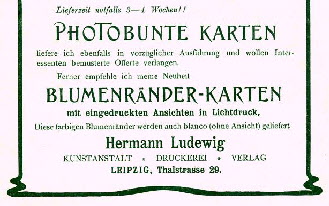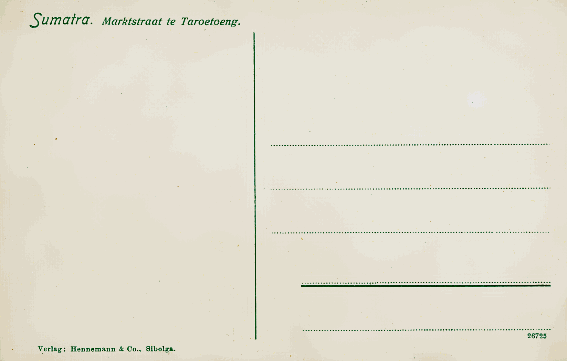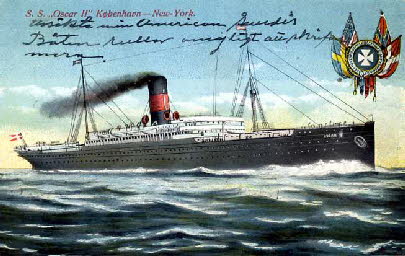|
|
 |
 |
|
THE POSTCARD ALBUM
POSTCARD PRINTER & PUBLISHER RESEARCH
|
|
|
|
 |
 |
|
Hermann Ludewig. another ppc printer/publisher from the city of Leipzig, is probably something for the advanced collector interested in ppc research only. The earliest card (p/u Aug. 1900) found comes from a series with colourful views of the Paris 1900 World Exhibition. Many cards (c. pre-1905) printed by Ludewig show name imprinted, usually with process name ‘Autocolor’ together with a tiny 4-digit card number in red ink either on picture or address side.
>> See TPA 31 for latest information on the printer Hermann Ludewig.
|
 |
 |
|
I discovered only a single type of logo yet. Found on Ludewig published cards from WW1 years only (see ill.) Identification of Ludewig printed cards is only possible with their card number together with some other layout aspects described below. There are exceptions of course! By the way, the quality of the ‘Autocolor’ (image by halftone, colours superimposed by litho process) was equal to that of Louis Glaser’s ‘Autochrom’ process. Ludewig cards are also sometimes mistaken with the products of local competitor Regel & Krug (‘Heliochrom’), who used also small size card numbers printed in red ink.
|
|
|
 |
 |
 |
 |
|
Company History
|
|
|
|
Otto Robert Hermann Ludewig set up his business in 1900 and although he used both processes, letterpress and lithography, he appears to have avoided the typical, popular then chromolitho “Greetings from...” cards.
|
|
|
|
The business was first found at Thalstr. 29, before he moved into his own house Leipzig-Stoetteritz, Schoenbachstr. 50 on Oct. 29, 1906. From May 1907 on the postcard publisher Trinks & Co. is found here, too.
|
|
 |
|
|
 |
|
|
Half of a Ludwig promo card. A view of Stuttgart (card no. 4173) on the back. Offered are full colour cards as well as a novelty, a flower frame design with views inserted by collotype process. Available also without imprint. H. Ludewig, Thalstr. = pre Oct. 1906 date.
|
|
 |
 |
|
Hermann Ludewig, who specialised almost fully on picture postcard printing, is said to have employed up to 100 people during the boom years. By late 1910 it had dropped to some 60-70 persons. For production he had 2 bigger format letterpress, 6 litho and 2 collotype presses. Plus some other machinery. Before 1914 a new (copper) gravure press was installed.
|
 |
 |
|
In 1924 the H. Ludewig business was taken over by well known local printing company Guenther, Kirstein and Wendler (establ. 1907), owners: Reinhold Wendler and Richard Guenther. Both firms were now found at Schoenbachstr. 50, the business continued under the name Hermann Ludewig. Now with more than 20 large and smaller format letterpress, 9 litho and 2 collotype presses and 115-120 workers. Besides picture postcards the company concentrated on catalogue and colour printing in general.
|
|
|
 |
 |
|
Basel, Switzerland, view of town hall. Ludewig ‘Autocolor’, card. no. 4824. No p/u, with the at that time typical Swiss undivided UPU back layout.
|
|
|
below: Sumatra, Bataksch dorp, published by Hennemann & Co., Sibolga. Divided back, not p/u with Ludewig number 26726 = post-1911 printing.
|
|
 |
 |
 |
|
This firm managed to stay in business during the difficult late 1920’s/early 1930’s, but had to reduce capacity and workforce by a great deal. Still listed in Klimsch addressbook 1933 under old name, but the 1935 edition lists it under ‘Guenther, Kirstein & Wendler’ again, employing 77 people and still with postcard printing among their various specialities. This company even survived WW2 years, always found at same location, and is even listed in the 1950 Polygraph Printing Trade directory again with various printing machines and 49 employees.
|
|
|
|
Identification of Ludewig printed postcards
|
|
|
As said above, this is not an easy task. Early Ludewig cards with name on, either ‘Autocolor’ halftone printed or by collotype process, are mostly of good to excellent quality. Later issues are often typical mass production quality, similar to that of Emil Pinkau.
|
|
|
|
The only constant identification mark of Ludewig is their small 5-digit card number which appears to be consecutive. Normally found at lower right corner position, the address side very often printed in green ink. However, there are exceptions. Address side printed in other colours, number found still below the writing line but arranged to the left side, the number rotated, part of lower section of the dividing line, no number at all, perhaps because of customer requirements. The relatively small, often printed in green ink 5-digit card number was sometimes mistaken with the numbering of C.G. Roeder, also from Leipzig.
|
|
|
|
|
 |
|
 |
|
Dutch ppc collector/researcher Henk Voskuilen from Amsterdam, has found out something that makes a identification of Ludewig cards (as well as that of many other printers) more likely. He noticed that composers / persons responsible for making the forme ready for print, followed routines. The basis elements on address side were rarely changed every time a new view was printed, only publisher name, trademarks and card information/caption. Dividing and writing lines, stamp box, the imprint “Postcard” either single or multi-lingual did not change – was used over and over again, except elements were damaged or used up.
|
|
|
|
 |
|
|
|
This is a typical Ludewig address side layout. Three dotted writing lines of equal length for title, name etc. Then the shorter, but thicker line for city with dotted line above. Finally another dotted line for the street with number at lower right corner position. This scan was worked on to make the thin dotted lines more visible at low resolution.
|
|
|
|
So far I have seen Ludewig printed (topo) cards from various European countries, USA and Asia. Plus shipping, social history, WW1 and subject cards. The mentioned numbers are always in the 20-30 thousand range which puzzles me a little bit. Reprints appear to have received the same card / order number again. As many (later) Ludewig cards are of common nature and quality they might not be of special interest to collectors. For ppc printer research however, Hermann Ludewig company is quite interesting.
|
|
|
|
 |
|
|
Danish passenger liner “Oscar II” on service between Copenhagen – New York. Mailed from Norway to Sweden in 1921. Ludewig no. 32307.
|
|
|
|